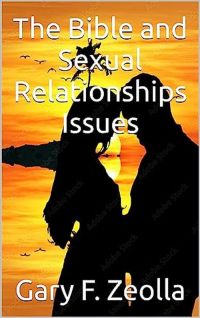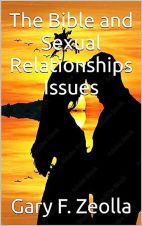
Additional Books and eBooks by the Director
Additional Books and eBooks by the Director
Book and eBook by Gary F. Zeolla, the Director of Darkness to Light ministry
This book looks in-depth at what the Bible has to say on sexual types of relationships and related issues. By this is meant: dating, pre-marital sex, marriage, divorce, re-marriage, marital sex, extra-marital sex, homosexuality, polygamy, incest, abortion, and birth control.
Note: This book is followed up by my much expanded two-volume God’s Sex Plan set.
Available Formats
Amazon:
Kindle Reading Device eBook: 209 KB. $2.99. Order and download from Amazon.
Paperback: 148 pages. $7.95. Order from the publisher via their website: Amazon.
Lulu Publishing:
Acrobat Reader® eBook: 135 pages. 1,145 KB. $2.99. Purchase and download from the publisher via their Web site: Lulu Publishing.
ePUB (for iPad, Nook, etc.) eBook: 165 KB. $2.99. Order and download from the publisher via their website: Lulu Publishing.
Paperback: 148 pages. $7.95. Order from the publisher via their Web site: Lulu Publishing.
Notes:
Different formats and publishers might have different covers, but the content is the same in all of them.
The links to Amazon are advertising links, for which I receive a commission in addition to my royalty if a product is purchased after following the link.
Sex and the Bible
The Three Books in this Series
The Bible and Sexual Relationships Issues
God’s Sex Plan: Volume One: What the Old Testament Teaches About Human Sexuality
God’s Sex Plan: Volume Two: What the New Testament Teaches About Human Sexuality
All three of these books were updated in 2023. The text is mostly the same, except to update the covers and appendixes and to correct a few minor typos. Also, an Epilogue was added to the final book.
Readers
Download the free PDF Reader (Acrobat Reader®)
Purchase the Kindle Wireless Reading Device
Preface
 This book will look in-depth at
what the Bible has to say on sexual types of relationships and related issues.
By this is meant: dating, pre-marital sex, marriage, divorce, re-marriage,
marital sex, extra-marital sex, homosexuality, polygamy, incest, abortion, and
birth control.
This book will look in-depth at
what the Bible has to say on sexual types of relationships and related issues.
By this is meant: dating, pre-marital sex, marriage, divorce, re-marriage,
marital sex, extra-marital sex, homosexuality, polygamy, incest, abortion, and
birth control.
This study will go through the Scriptures systematically, looking at relevant passages of Scripture in order. The passages are written out, with the bulk of this book being simply the Scriptures, so the reader can see for yourself what the Bible teaches on various sexual issues.
Explanations and interpretations are provided for each passage to aid the reader in understanding the Scriptures, but the emphasis is on the Scriptures themselves. This format will enable the reader to draw conclusions about what the Bible as a whole has to teach on these personal and very relevant issues.
The Old Testament texts are taken from the World English Bible (WEB), a modern-day public domain version, while the New Testament texts are taken from the author’s own Analytical-Literal Translation of the New Testament: Third Edition (ALT3).
Table of Contents
Preface - 5
Abbreviations - 7
The Old Testament … 9
Chapter
#1 – Genesis - 11
#2 – The Rest of the Torah - 39
#3 – The Historical Books - 53
#4 – The Poetic Books - 71
#5 – The Prophetic Books - 77
The New Testament … 87
#6 – The Gospels and Acts - 89
#7 – The Pauline Epistles - 101
#8 – The General Epistles - 119
#9 – The Revelation - 125
#10 – Conclusion - 129
Appendixes … 131
#1 – Additional Books by the Author - 133
#2 – Author’s Web Sites, Newsletters, and Social Sites/
Contacting the Author - 137
![]() Additional
Books and eBooks by the Director
Additional
Books and eBooks by the Director
![]() Subject Index
Subject Index
![]() Contact
Information
Contact
Information
![]() Alphabetical List of
Pages
Alphabetical List of
Pages
Darkness
to Light Home Page
www.zeolla.org/christian